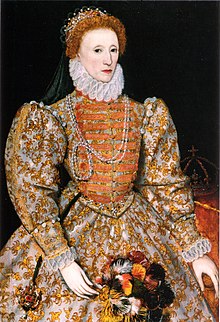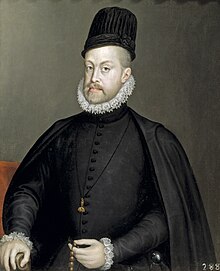
Charles Blount, 1st Earl of Devonshire, KG was an English nobleman and soldier who served as Lord Deputy of Ireland under Queen Elizabeth I, and later as Lord Lieutenant of Ireland under King James I.
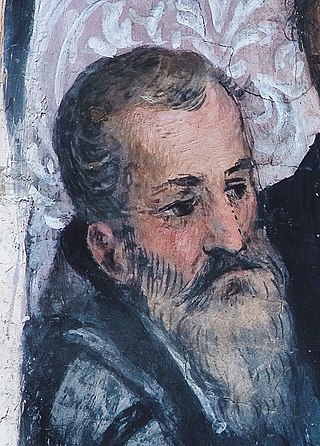
Hugh O'Neill, was an Irish Gaelic lord, Earl of Tyrone and was later created The Ó Néill Mór, Chief of the Name. O'Neill's career was played out against the background of the Tudor conquest of Ireland, and he is best known for leading a coalition of Irish clans during the Nine Years' War, the strongest threat to the House of Tudor in Ireland since the uprising of Silken Thomas against King Henry VIII.
Manus O'Donnell was an Irish lord and son of Sir Hugh Dubh O'Donnell. He was an important member of the O'Donnell dynasty based in County Donegal in Ulster.

The Flight of the Earls took place in September 1607, when Hugh O'Neill, 2nd Earl of Tyrone, and Rory O'Donnell, 1st Earl of Tyrconnell, and about ninety followers, left Ulster in Ireland for mainland Europe. Their permanent exile was a watershed event in Irish history, symbolising the end of the old Gaelic order.

Rory O'Donnell, younger brother of Hugh Roe O'Donnell, was the last King of Tyrconnell and 1st Earl of Tyrconnell.
Hugh Roe O'Donnell, also known as Red Hugh O'Donnell, was a sixteenth-century leader of the Gaelic nobility of Ireland. He became Chief of the Name of Clan O'Donnell and Lord of Tyrconnell in 1593, following a lengthy succession dispute within the derbhfine of the O'Donnell dynasty, and after escaping a five-year imprisonment without trial in Dublin Castle. Along with his father-in-law Hugh O'Neill of Tyrone, he led an alliance of Irish clans in the Nine Years' War against the English government in Ireland. Hugh Roe led an Irish army to victory in the Battle of Curlew Pass. After defeat in the Siege of Kinsale, he travelled to Spain to seek support from King Philip III. Unsuccessful, he died in Spain and was succeeded by his younger brother Rory O'Donnell. He is sometimes also known as Aodh Ruadh II or Red Hugh II, especially in his native County Donegal.
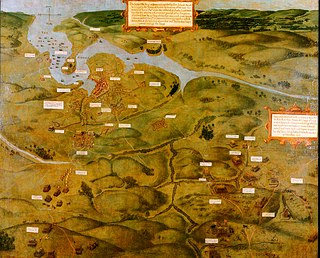
The siege of Kinsale, or battle of Kinsale, was the ultimate battle in England's conquest of Gaelic Ireland, commencing in October 1601, near the end of the reign of Queen Elizabeth I, and at the climax of the Nine Years' War—a campaign by Hugh O'Neill, Hugh Roe O'Donnell and other Irish lords against English rule.

The O'Donnell dynasty were the dominant Irish clan of the kingdom of Tyrconnell, Ulster, in medieval Ireland.
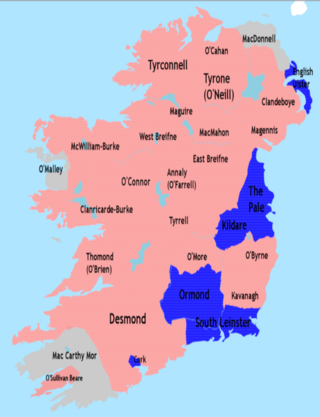
The Nine Years' War, sometimes called Tyrone's Rebellion, took place in Ireland from 1593 to 1603. It was fought between an Irish alliance—led mainly by Hugh O'Neill of Tyrone and Hugh Roe O'Donnell of Tyrconnell—against English rule in Ireland, and was a response to the ongoing Tudor conquest of Ireland. The war was fought in all parts of the country, but mainly in the northern province of Ulster. The Irish alliance won some important early victories, such as the Battle of Clontibret (1595) and the Battle of the Yellow Ford (1598), but the English won a victory against the alliance and their Spanish allies in the siege of Kinsale (1601–02). The war ended with the Treaty of Mellifont (1603). Many of the defeated northern lords left Ireland to seek support for a new uprising in the Flight of the Earls (1607), never to return. This marked the end of Gaelic Ireland and led to the Plantation of Ulster.

The Battle of the Yellow Ford was fought in County Armagh on 14 August 1598, during the Nine Years' War in Ireland. An English army of about 4,000, led by Henry Bagenal, was sent from the Pale to relieve the besieged Blackwater Fort. Marching from Armagh to the Blackwater, the column was routed by a Gaelic Irish army under Hugh O'Neill of Tyrone. O'Neill's forces divided the English column and a large earthwork stalled its advance. Bagenal was killed by an Irish musketeer, and scores of his men were killed and wounded when the English gunpowder wagon exploded. About 1,500 of the English army were killed and 300 deserted. After the battle, the Blackwater Fort surrendered to O'Neill. The battle marked an escalation in the war, as the English Crown greatly bolstered its military forces in Ireland, and many Irish lords who had been neutral joined O'Neill's alliance.

Tír Eoghain, also known as Tyrone, was a kingdom and later earldom of Gaelic Ireland, comprising parts of present-day County Tyrone, County Armagh, County Londonderry and County Donegal (Raphoe). The kingdom represented the core homeland of the Cenél nEógain people of the Northern Uí Néill and although they ruled, there were smaller groups of other Gaels in the area. One part of the realm to the north-east broke away and expanded, becoming Clandeboye, ruled by a scion branch of the O'Neill dynasty. In one form or another, Tyrone existed for over a millennium. Its main capital was Dungannon, though kings were inaugurated at Tullyhogue Fort.
Events from the year 1607 in Ireland.
Brian O'Neill, also known as Brian "of the battle of Down" O'Neill, was the High King of Ireland from 1258 to 1260.

Tibbot na Long Bourke, 1st Viscount Mayo was an Irish peer and parliamentarian. A prominent member of the MacWilliam Burkes of County Mayo, Tibbot was a Member of the Irish House of Commons and was later created the first Viscount Mayo. His successful life followed, and usefully illustrates, the difficult transition for Irish aristocrats from the traditional Gaelic world during the Tudor conquest of Ireland.
Con(n) MacShane O'Neill (1565–1630) was an Irish flaith or Prince of Ulster, the Lord of Clabbye, nobleman, rebel, and political leader in the late 16th century and early 17th century.
Tibbot MacWalter Kittagh Bourke, 21st Mac William Íochtar was the first and last person to hold that title following its restoration. He was inaugurated at Kilmaine by Hugh Roe O'Donnell in December 1595 to secure Mayo for the rebel Irish Alliance during the Nine Years' War. His rule was opposed by many Bourke nobles, most notably by his arch-rival, the loyalist chief Tibbot na Long Bourke. The two men fought for supremacy over the MacWilliam Lordship throughout the war and control of the area changed hands on numerous occasions. Following Kittagh's flight to Spain in 1602, the MacWilliam chieftainship was abolished yet again, and Tibbot na Long would thereafter be made Viscount Mayo.
The Treaty of Mellifont, also known as the Articles of Mellifont, was signed in 1603 and ended the Nine Years' War which took place in the Kingdom of Ireland from 1594 to 1603.
Sir Francis Roe, alias Rooe (c1570-1620), was an English-born infantry officer who served in Ireland during the Nine Years' War, obtained grants of land during the Plantation of Ulster, and became a member of the Parliament of Ireland and mayor of Drogheda.

The Kingdom of West Breifne or Breifne O'Rourke was a historic kingdom of Ireland that existed from 1256 to 1605, located in the area that is now County Leitrim. It took its present boundaries in 1583 when West Breifne was shired and renamed Leitrim, after the village of Leitrim, which was an O'Rourke stronghold. The kingdom came into existence after a battle between the ruling O'Rourke clan and the ascendant O'Reillys caused the breakup of the older Kingdom of Breifne and led to the formation of East Breifne and West Breifne. The kingdom was ruled by the O'Rourke clan and lasted until the early 17th century, when their lands were confiscated by England.
Teigue O'Rourke (1576–1605) was the last king of West Breifne from 1603 until his death in 1605. He was the son of Brian O'Rourke and Mary Burke of Clanricarde. Raised by his mother in County Galway, he lived most of his life in exile from his kingdom, looking for allies to support his claim as king of West Breifne in opposition to his half-brother Brian Oge O'Rourke. Having initially supported the Irish alliance during the Nine Years' War, he switched allegiance to England following the Battle of Kinsale in 1602. With the support of English forces he invaded West Breifne in 1603, ousting his half-brother and ruling as king until his unexpected death in late 1605 at the age of 28.



